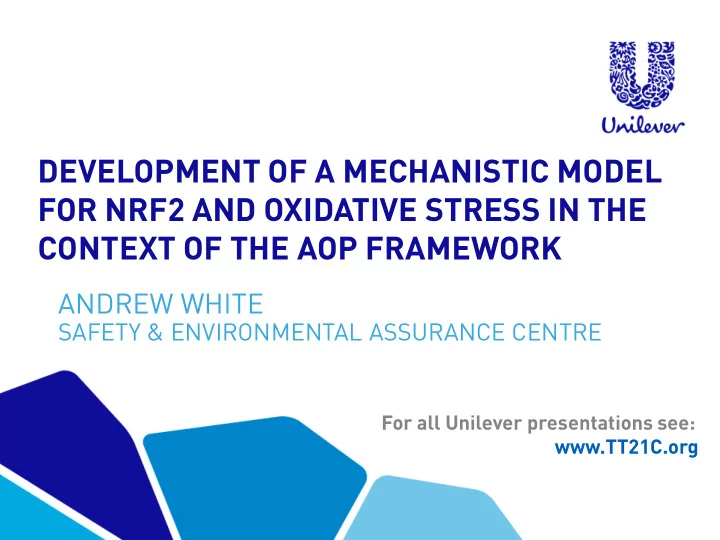

DEVELOPMENT OF A MECHANISTIC MODEL FOR NRF2 AND OXIDATIVE STRESS IN THE CONTEXT OF THE AOP FRAMEWORK ANDREW WHITE SAFETY & ENVIRONMENTAL ASSURANCE CENTRE For all Unilever presentations see: www.TT21C.org
OUTLINE OF TALK • Background of project and objective for the development of the oxidative stress AOP • Scope of the systems model • Approaches for translation of model for decision making
MAIN AIMS OF USING THE OXIDATIVE STRESS SYSTEM AS A CASE STUDY • Build capability in understanding how to apply this approach to a general stress mechanism • Understand the behaviour of an integrated system centred on homeostasis control to enable chemical risk assessment • Define molecular events that lead to adverse effects and select appropriate biomarkers and pathways based on relevant biology » so that adverse effects measured in in vitro systems could be correctly interpreted in the context of risk for human health
OXIDATIVE STRESS -OVERVIEW Cellular /Environmental Catalase, Thierodoxin, GPx Transcription Cellular Sources, al Adaption Non – enzymatic eg. Cytosolic/Mitochondrita eg. Nrf2 Glutathionine, Ascorbate Balance between ROS production and ROS removal by scavenging mechanisms Downstream consequences Removal Repair Altered cell signalling, Protein oxidation, Lipid Peroxidation, DNA damage, Mitochondria damage Altered Cellular processes Apoptosis, Necrosis, Proliferation, Differentiation, Inflammation,
OXIDATIVE STRESS AS A CLASSICAL CASE STUDY FOR ADAPTIVE RESPONSES An existing biochemical circuit in the cell that, when sufficiently perturbed, is expected to result in an adverse health effect. Exposure Tissue Dose Biological Interaction Perturbation Normal Biological Biological Inputs Function Adaptive Stress Altered Responses and Cellular Homeostasis Responses Cell Adverse Dysfunction Health Outcomes Adapted from Toxicity Testing in the 21st Century: A Vision and a Strategy, the U.S. National Academy of Sciences
OXIDATIVE STRESS AOP UNDERSTANDING COMPLEX INTERACTIONS Modified network of oxidative stress as depicted by sbv improver. https://sbvimprover.com/
SCOPE OF LIVER OXIDATIVE STRESS SYSTEMS MODEL
SCOPE OF LIVER OXIDATIVE STRESS SYSTEMS MODEL – NRF2 SUBMODULE
IN VITRO MEASUREMENTS - REDOX IMPACT Key Parameters – Inputs; Modulators Outputs; Signal transducer
IN VITRO MEASUREMENTS – CELLULAR OUTPUTS Protein Carbonylation Protein Nitrosylation Current data does not show a robust protein carbonylation response in HaCat cells at exposure concentrations that have been shown to induce other markers of oxidative stress
IMPACT OF NRF2 ON KEY PARAMETERS GCLC
IN SILICO SIMULATION NRF2 AND KEAP1 KNOCKOUT STUDIES COMPARISON Results from literature [Wu] Simulation results 3.5 Nuclear Nrf2 3 g GCS NQO1 2.5 Nrf2 KO 0 2 wild type 1.5 Keap1 KD 1 Keap1 KO 0.5 0 Nrf2 wild Keap1 Keap1 KO type KD KO 1.4 … GSH fold 1.2 1 0.8 0.6 0.4 0.2 0 Nrf2 KO wild Keap1 Keap1 type KD KO Kai Connie Wu et al, Beneficial Role of Nrf2 in Regulating NADPH Generation and Consumption, TOXICOLOGICAL SCIENCES 123(2), 590 – 600 (2011)
IN SILICO SIMULATION PROTEIN THIOL BUFFERING Type of thiol description Experiment Simulation results Results PSH % of total 56 +/-10 55% Protein thiols PSSG % of total 19 +/-4 20% Protein thiols PSSP % of total 25 +/-11 25% Protein thiols GSH % of total GSH 37 +/-14 31% equivalents Rosa E. Hansen, et al, Quantifying the global cellular thiol – disulfide status, PNAS January 13, 2009 vol. 106 no. 2, 422-427 Cytosolic PSH Cytosolic PSSG Cytosolic PSSP
STRESS CONDITIONING SIMULATION – REPEAT DOSE Stage of expt Parameter Fold change in Fold change reference [JZC] in our simulations After first pulse MDA Approximately 2 1.95 4-HNE Approximately 2 1.945 GST protein at 2 hrs 2.7 2.82 SH-HNE elimination rate at 2.9 3.8 2 hrs GSH at 2 hrs Not shown 0.85 After challenge dose 4-HNE any point of time <1.5 1.31 Ji-Zhong Cheng et al, Accelerated Metabolism and Exclusion of 4-Hydroxynonenal through Induction of RLIP76 and hGST5.8 Is an Early Adaptive Response of Cells to Heat and Oxidative Stress J. Biol. Chem. 2001, 276:41213-41223
STRESS CONDITIONING SIMULATION – REPEAT DOSE Cytosolic 4-HNE Cytosolic MDA Elimination of 4-HNE Cytosolic GSH
DETERMINATION OF REDOX SENSITIVE COMPONENTS OF THE MODEL – GLUTATHIONE REDOX POTENTIAL
TRANSLATION – CONTEXT VIA CORRELATE LEVELS OF CELL DAMAGE AND RECOVERING TO PHYSIOLOGICAL PROCESS From S. Mrakic-Sposta etal. OxiMed2012-973927 Adaptive Adverse region Non perturbed Adverse response region 3.5 3 control day 2.5 1.2 LPO 2 1 0.8 1.5 0.6 1 0.4 0.5 0.2 0 0 LPO PC GSSG GSH control control day night Background Concentration
TRANSLATION – NEW TOOLS FOR IMPROVED QUANTITATIVE TIME RESOLVED RESOLUTION
SUMMARY/NEXT STEPS Have used the AOP approach as a framework to describe • the relationship between key events across scales for oxidative stress. Developed a model to quantify the relationships between • the events and understand the homeostatic control of the system. Reiterative approach to assess and refine model. Have tools in place to determine some of the key • parameters however there are still further required. Looking at how we can use the outputs to understand the • adaptive/adverse continuum to enable decision making. Further additional work is necessary to finalise the model, • eg. biokinetics to aid translation to risk assessment.
ACKNOWLEDGEMENTS Unilever Strand Life Sciences Mahesh Batakurki Kas Subramanian Paul Carmichael Narasimha M.K Kristina Castle Nalina R Sarah Cooper Carol Courage Leiden University Penny Jones Gaurav Jain Bob van de Water Stephen Glavin Stephen Wink Jaya Vethamanickam Tk, Sivaram Hamner Institute Rebecca Clewell Jingbo Pi () Bin Sun Bo-Wen Huang Mel Anderson
Recommend
More recommend